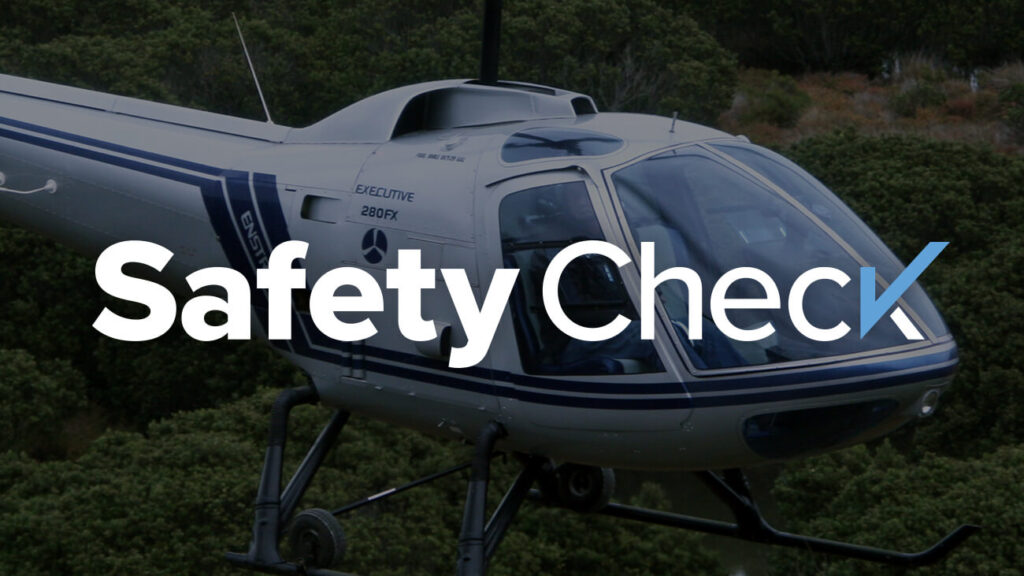Safety Check: Summer Flying Tips

As I type this month’s Safety Check, I can hear a group of local pilots discussing their plans to fly to AirVenture in Oshkosh, WI. Organizers expect more than 10,000 aircraft to be there. We’re expecting good flying weather, but the hot summer air can still pose a few challenges. Here are a few tips to flying safe in the summer.
First, check the day’s density altitude. High density altitude can degrade your helicopter’s performance, especially in confined areas that require maximum power. Hot and humid days can skew your density altitude well above normal. For example, the ambient air temperature today at KGSH is 82° and the dewpoint is 58°. The density altitude measured out to 2,400 feet or about 3 times the actual elevation. On days like this, my best advice is to keep your helicopter’s weight as low as possible and be conservative with your aircraft performance calculations.
The summer heat might feel sweltering, but it’s no excuse for neglecting to check for carburetor icing. Here’s a good rule of thumb: if the relative humidity is above 50% or if the dew point falls within 5° of the ambient temperature, it’s imperative you take steps to reduce your risk of icing. I should note, Enstrom piston helicopters use fuel injections to eliminate the need for carb heat.
However, if you’re flying another make or model, check your Pilot Operating Handbook for specifics on using carburetor heat at lower power settings.
No pilot chooses to fly through a thunderstorm, but if you skip your pre-flight weather briefing, you could find yourself face to face with one. Cold fronts often bring areas of frontal thunderstorm development with them. I encourage you to relearn your cloud types and be on the lookout for clouds with rapid vertical development. These clouds often contain dangerous thunderstorms with hail and gusty winds. The FAA recommends keeping a 20-mile gap between you and the storm. Under no circumstances should you ever fly closer than five miles away from a storm.
Avoid the temptation to fly underneath a thunderstorm too. You’ll only find severe turbulence, windshear, and possibly hail down there. Satellite weather subscriptions are helpful in some circumstances, but they should never replace live weather radar and common sense.
If you’re expecting a scorcher in the afternoon, fly in the morning when it’s cooler. Pilots see their worst turbulence on the warmest of days. As the sun heats up the earth’s surface throughout the day, hot air rises into the atmosphere, creating an upward flow known as convective turbulence. Convective turbulence can sometimes exceed 5,000 feet when the conditions are right. So, the earlier in the day you fly, the fewer hot air masses you’ll encounter. For those of you who aren’t really early birds, your best time to fly is early evening after the air temperatures have stabilized.
You’ll want to be extra careful about hot starts. In a fuel-injected piston engine, quick turns in hot and humid conditions can create vapor lock. Vapor lock occurs when your liquid fuel becomes so hot that it turns to vapor. When you start your engine, the fuel pump has no feed pressure and can’t pump the vaporized fuel through the fuel lines designed for liquids. Unfortunately, the only way to fix this problem is to replace the vaporized fuel. You can use the boost pump to push liquid fuel into the lines, but that risks flooding the engine if you pump too much. Review your POH for hot start instructions.
For turbine engines, the term “hot start” takes on a different, more expensive meaning. Quick turns in turbine engines like Enstrom’s 480B require more attention during the start sequence. You’ll usually need to try “Motoring” or “Cranking” the engine before you introduce any fuel.
Finally, keep your headsets and iPad protected from the heat. A recent experience reminded me of how hot the interior of a helicopter can get. I’d hopped into the middle seat of a late model H130 and noticed the owner had set a fitted glove over the PIC’s cyclic control. A smart move, because when I touched the unprotected co-pilot’s cyclic, it felt significantly warmer. That kind of heat can quickly over-temp your electronics. Headsets left to cook in the sunlight might initially be too hot to be usable and remain uncomfortably warm for the rest of your flight.
If you take all these tips to heart, I know you’ll have a safe and fun summer of flying.

Randy is a dual rated Airline Transport Pilot with 13,000 flight hours in airplanes and helicopters. He has type ratings in the BE400 and CE500. Randy has been a rotorcraft Designated Pilot Examiner representing the Grand Rapids FSDO since 2014. Currently he works for Sweet Helicopters, a northern Indiana Part 135 air carrier operator and serves as the Airport Manager of the Goshen Municipal Airport.
About Enstrom Helicopter
From Rudy Enstrom’s early designs in 1943 to initial testing in a Michigan Quarry in 1957 to aircraft operating on six continents, Enstrom Helicopter Corporation has maintained a reputation for safety, value and performance. Based in Menominee, Michigan and proudly made in the United States, Enstrom has a rich history for design innovation. The goal is to provide helicopters to the customer’s exact specification and deliver support and maintenance worldwide.